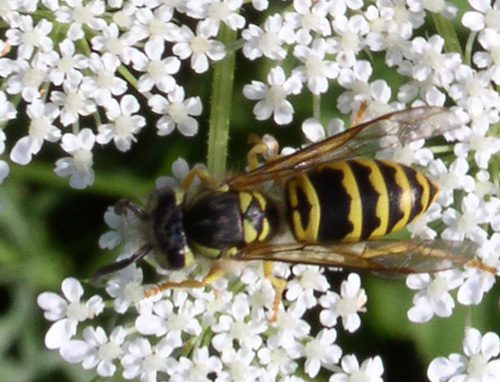Looking more closely at those pesky yellow jackets

While gathering apples from my grandmother’s tree, or picking up persimmons early in the season, we had to deal with a pesky little insect – the yellow jacket. They had a colonial home in a stump near our persimmon tree. Fortunately, only once have I encountered a yellow jacket nest while walking in the woods. I was able to get through it quickly enough so that I suffered only three minor stings.
Yellow jackets are all too common, even outside the deep woods, and I was reminded of this recently when one flew over to bug me as I tried to eat my lunch outdoors.
Yellow jackets are sometimes mistakenly called bees, but are a predatory wasp. They are about a half inch long and have black and yellow bands across their abdomens.
They have stingers with small barbs and can sting repeatedly, although only the females can sting. Their nests are paper-like and built from wood fibers the yellow jackets chew up into a quick-drying, pulp-like substance. They build their nests on the ground or sometimes in the walls of structures, and they will defend their nest.
They live in colonies with workers, queens and drones, and one colony can have as many as 5,000 members. The colonies persist only for one year, and only the fertilized queens overwinter and survive until the next spring.
In winter the queen enters diapause, or a state of dormancy, until late spring or early summer, when she emerges and builds a small paper nest and lays a small number of brood to start with. Those larvae emerge as female worker bees that then take over the feeding of additional larvae. Food may consist of fruit or other insects.
The species found commonly around is the Eastern Yellow Jacket (Vespula maculifrons). They are found all across eastern North America. The first insect I was ever stung by was a yellow jacket, not surprising when you learn that almost half of all insect stings are from yellow jackets. They can pose a bigger problem for people who are allergic. When one stings, it releases a pheromone that attracts the other yellow jackets near the nest and prompts them to sting the target, as well.
As much of a pest as they are, though, yellow jackets are not all bad. They exhibit a form of commensalism, a type of symbiosis whereby one organism benefits and another neither benefits nor is harmed.
A species of house fly lays its eggs on the outer portion of the yellow jacket nest. Their larvae fall to the ground and eat the waste products from the yellow jacket nest. In addition, they are beneficial to humans in one regard—they are good at killing pests like caterpillars and particularly pests that eat crops and ornamental plants.
So while they can be considered a pest, they do have a positive side. That’s easier to remember when you can stay safely away from their nests, and away from their painful, stinging reminders to you to keep your distance.